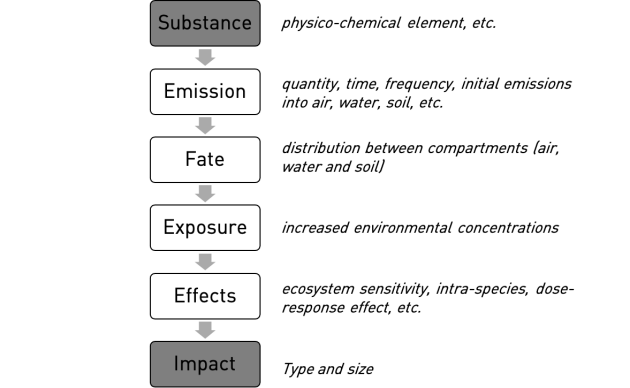Impact assessment
Impact assessment involves translating elementary flows into quantified environmental impacts.
Texte légal :
An environmental impact is defined as ‘any change to the environment, whether adverse or beneficial, resulting in whole or in part from the environmental aspects of an organization’. ISO 14001:2015
From substance to impact
Concepts of eco-toxicology
Environmental impact is determined by a number of factors.
Initially, when a substance is emitted into the environment, the environmental impact will vary according to the quantity emitted, the time over which the substance is emitted, the initial medium into which it is emitted, etc. The substance is then distributed into one or more compartments (also called fate). The substance is then distributed in one or more compartments (also called fate). Depending on the time of exposure to a given concentration and the specific sensitivity of the ecosystem, dose-response and dose-effect effects, etc., the environmental impact will be different.
Exemple : Climate change
Climate change is the best-known and most widely recognised environmental impact. It is a so-called global impact because it has an influence on a planetary scale, although its consequences vary from region to region.
A wide range of substances contribute to climate change (CO2, CH4, NO2, CF4, etc.), each with a different warming potential and lifetime. In order to compare their effects over a given period (generally 100 years), the impacts of these substances are expressed in the same unit: kg CO2 eq.
So if we know the nature and quantity of substances emitted into the air by an activity, we can determine its environmental impact in kg CO2 eq.
Remarque : In practice
By combining environmental databases (materials, processes, etc.) with an assessment method, environmental indicators can be calculated automatically.
Attention :
The choice of method, and therefore of potential impact indicators, is one of the elements to be defined during the first stage of the LCA.
Life Cycle Assessment results
There are three main ways of representing environmental impacts:
characterisation;
standardisation;
single score.
Characterisation
According to the ILCD Handbook[2] (general guide for LCA, detailing the ISO 14040-[3] [3]44 :2006+A1-A2:2020[4] standard), characterisation is the only mandatory representation of LCA results. It enables substance flows to be associated with potential impacts on the basis of characterisation factors, as described above.
Exemple :
When an LCA is carried out on a product, service or system, the results are generally expressed in the form of a bar chart. Each environmental impact is generally represented by a bar ranging from 0 to 100% (left-hand graph). The contributions of the sub-systems are proportionally represented for each. In the graph on the left, the use phase has the greatest overall impact on the different categories, followed by the metals used in the manufacturing phase.
When the results are compared between several systems, the one with the greatest impact generally takes the value of 100%, while the others are represented relatively. It is also possible to consider that one of the systems is the reference (left graph).
Standardisation
It consists of dividing the value of a flow or impact by the value of the same flow or impact on the scale of a given territory.
The results are therefore said to be normalised in relation to this specific reference framework.
Standardisation is an optional stage in LCA.
The single score consists of aggregating different environmental indicators into a single indicator.
It makes the results easier to read, but gives a partial picture of the impacts and can mask important information.
This is an optional step in the LCA process that should be handled with care.

